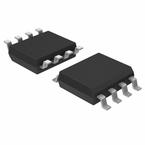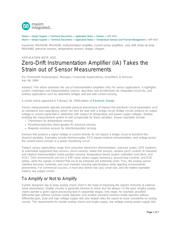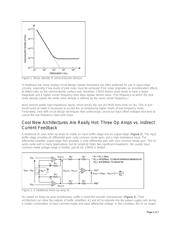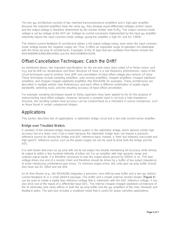下载

Maxim > Design Support > Technical Documents > Application Notes > Sensors > APP 4437
Maxim > Design Support > Technical Documents > Application Notes > Temperature Sensors and Thermal Management > APP 4437
Keywords: MAX4208, MAX4209, instrumentation amplifier, current sense amplifiers, zero drift, three op amp,
MAX4460, pressure sensors, temperature sensors, bridge, chopper
APPLICATION NOTE 4437
Zero-Drift Instrumentation Amplifier (IA) Takes the
Strain out of Sensor Measurements
By: Prashanth Holenarsipur, Manager, Corporate Applications, Amplifiers & Sensors
Apr 06, 2009
Abstract:
This article
examines the use of instrumentation amplifiers (IAs) for sensor applications. It highlights
system challenges and implementation choices, describes new architectures for integrated-circuit IAs, and
outlines applications such as ratiometric bridges and low-side current sensing.
A similar article appeared in February 28, 2008 edition of Electronic Design.
Sensor measurements typically translate physical phenomena of interest into electronic-circuit parameters such
as resistance and capacitance, which can then be read with a bridge circuit. Bridge circuits produce an output
voltage or current signal that is ratiometric with respect to temperature and power-supply voltages, thereby
enabling the measurement system to self-compensate for these variables. Sensor examples include:
Thermistors for temperature sensing
Resistive/capacitive strain gauges for pressure sensing
Magneto-resistive sensors for direction/position sensing
Sensors that produce a signal voltage or current directly do not require a bridge circuit to transform the
physical variables. Examples include thermocouples, ECG-based medical instrumentation, and voltage across
the current-sense resistor in a power-monitoring circuit.
Today's sensor applications range from consumer electronics (thermometers, pressure scales, GPS systems),
to automotive equipment (fuel sensors, knock sensors, brake-line sensors, window pinch control), to industrial
and medical instrumentation (valve-position sensing, temperature-based system calibration and alarm, and
ECG). Their environments are rich in EMI noise, power-supply harmonics, ground-loop currents, and ESD
spikes, while the signals of interest that are to be extracted are extremely small. Thus, the analog-sensor
interface becomes nontrivial, and must maintain exacting specifications while rejecting environmental
phenomena. For commercial success, it must also deliver low cost, small size, and (for battery-operated
meters) low supply current.
To Amplify or Not to Amplify
System designers like to keep analog chains short in the hope of improving the signal's immunity to external
noise phenomena. (Digital circuitry is generally immune to noise, but not always.) In the past, lengthy analog
chains tackled a given signal-processing task in sequential stages. One stage, for example, provided
differential gain without common-mode rejection, and another provided common-mode rejection without
differential gain. Dual and high-voltage supply rails also helped relax the signal-to-noise constraints on analog
circuits. The requirements for shorter analog chains and single-supply, low-voltage analog power-supply rails
Page 1 of 7








